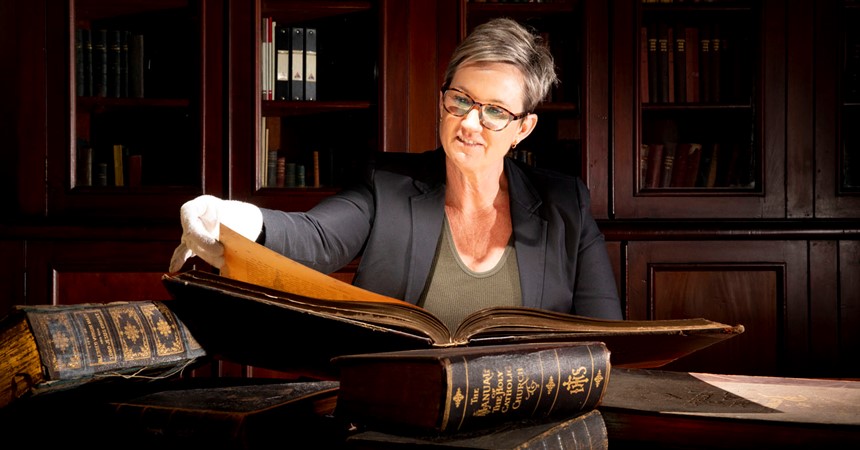The predominantly Catholic men had rebelled against British rule in Canada and were rounded up and transported to Australia in absolute squalor aboard the convict ship Buffalo. The horrifying tale was recounted in the memoir, Journal d’un exile politique aux Terres Australes, written in 1845 by French Canadian man Leandre Ducharme, one of the convicts aboard the Buffalo.
A rare first edition of the memoir is one of the highlights of the Australian Catholic University’s (ACU) new historical archive of books, manuscripts and artefacts that document the history of the Catholic Church in Australia.
Antiquarian bookseller and collector, Hugh Myers, is the ACU special collections adviser for the archive and said Ducharme’s memoir was a highly “significant and desirable book” relating to convict-era history. “Having been denied water, the men basically went insane with thirst,” Mr Myers said. “It was a particularly brutal and sadistic voyage even by the standards of the time.”
In Sydney to meet the stricken men were Father John Brady and Bishop John Bede Polding. The latter was to become Australia’s first bishop when he was consecrated Archbishop of Sydney in 1841.
“Bishop Polding conducted a mass in the hull of the Buffalo, which would have been absolutely putrid,” Mr Myers said. “The French Canadian exiles were originally destined for Norfolk Island, a violent and sadistic place that led many to choose suicide rather than be sent there.
“Bishop Polding personally intervened on their behalf with the governor and halted their transportation to Norfolk Island, saving their lives. Ducharme later wrote of Bishop Polding in his autobiography,” Mr Myers said.
The idea of pulling together rare books and artefacts was the brainchild of ACU vice-chancellor Greg Craven. Mr Craven first raised the matter in 2016 as part of the university’s broader arts and culture program and because he feared valuable material could easily be lost in the digital age.
“The rare book collection is a key component of our role as a leading Catholic institution and is integral to our Arts and Culture Strategy,” Mr Craven said. “In just over two years, the collection has grown to more than 1000 books, manuscripts, ephemera and historical objects.”
Some of the stand-out items in the archive include printed and manuscript material by the first Catholic priests in Australia, who accompanied the La Pérouse expedition and landed in Botany Bay in January 1788; three pamphlets by William Duncan, published from 1843 to 1856; two books published by Edward Flanagan, celebrating the scholarly achievements of his brother Roderick; and an inscribed presentation copy of On the Volcano of Taal by Reverend Tenison-Woods.
Mr Myers, who has 20 years’ experience as a buyer and seller of antique books, has also been given an annual purchase budget of about $50,000 to create a rich and diverse “haven for rare books”. “I’ve purchased close to 1000 books from around the country and internationally. The material is being digitised as we speak,” Mr Myers said.
For anyone who may be put off due to the religious nature of the material, Mr Myers says the collection is so much more than an ecclesiastical history. “It’s essentially for anyone interested in Australian social history, which was heavily influenced by convicts, one third of whom were Irish Catholics,” Mr Myers said. “Sending convicts to Australia was a way of taking the heat out of the political unrest in Ireland leading up to the potato famine in the 1840s and to stop rebellions, which occurred anyway in the 1860s.”
In Australia, however, as in Ireland, the fundamental political power lay with the Church of England, which ultimately led to divisions along religious lines. “People felt the Catholic/Protestant difference very acutely and the division became a huge part of Australia’s identity,” Mr Myers said.
Diocese of Maitland-Newcastle head of information management services, Juliet Hart, helps maintain its own small collection of rare books and artefacts and says it will be “fascinating” to spend time with the ACU collection, in particular to see how this region fits into the greater picture of the history of the Church in Australia.
“Historical books are often just beautiful items to look at and the ACU collection will provide a unique look at a segment of not only Australian religious life but life in general in Australia,” Ms Hart said. “I’m fascinated also to see what they hold in relation to this Diocese and what we might be missing from our own archive.”
The collection will be housed in North Sydney but is currently being digitised and will be publicly accessible from early next year. For more information visit the ACU arts and culture website.






















































































